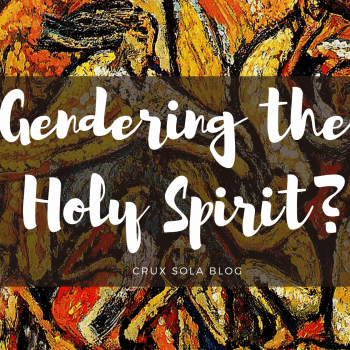Looking for Part 1? Click here
What is a “Spirit”?
In order to get at an answer to the question, is the Holy Spirit a “he”?, we need to step back and ask, “what is a ‘spirit'”? According to the New Testament, Spirit (pneuma) language is used for essentially three things: the (1) Holy Spirit/God’s Spirit, (2) unclean (i.e., evil) spirits, and (3) the human spirit.
We will spend another blog post later on looking at how the NT describes the Holy Spirit, let’s look now at the other two.
Unclean spirits. The Gospels and Acts make reference to “unclean spirits” that seek to possess and torment mortal bodies. Correspondingly, they lack in themselves a physical or fleshly form. In some ways they act like humans. They can make sounds and speak (Mark 1:26; 3:11; 5:12). Jesus talks to them directly, on one occasion says something like “Hey you, Spirit…” (Mark 9:25). They can have names, but this is rarely attested in the NT and may be more like a title than a personal name (Mark 8:30).
While spirits seem to have some human-like aspects (speech, intellect, personal choice), they are clearly a unique set of beings: “When the unclean spirit has gone out of a person, it wanders through waterless regions looking for a resting place, but it finds none” (Matt 12:43). These are unique beings, not distinguished according to sexual behavior. We might think of them like aliens, non-carbon-based forms that interact like humans but are not human. Therefore, there is no assumption of sexual or gender identity; in that case it doesn’t make sense to refer to one as “he.” If we extrapolate that the Holy Spirit is a good/holy version of the same type of being/existence/form, then we ought not to attribute to God’s Spirit “he-ness.”
Human spirit. This is a complex subject, but NT writers commonly referred to the human having a “spirit,” something like their deeper or inner self. Debates rage about whether “spirit” referred to a part of the person or one perspective on or frame of view of human existence. My take is that it was not that unlike talking about “soulmates” today; we know we are embodied people, but there is some sense of the self that transcends skin, cells, and synapses. The ancient “spirit” (pneuma) was like the animating power source of the person. It might be going too far to say the human spirit was conceived of as a completely separate being from the embodied person. At the same time, there is no indication the human spirit was gendered or sexualized. For example, Luke refers to a revived dead girl as having “her spirit (pneuma) returned” (Luke 8:55). As grammatically proper, pneuma is neuter; the fact it is a girl’s body that is reanimated does not affect that. The “spirit” is not more feminine because it is a girl that is involved. The same would naturally be true for a “man’s spirit.” Each person has a spirit (pneuma) but that pneuma is never treated with sex or gender. It is anyone’s guess where the (sexless) pneuma ends and the embodied (sexual) person begins. Still, I doubt that ancient writers ever thought of the human spirit as “he” or “she.” But even if they did, what would they think of God’s Spirit? Because God does not have a body (John 4:24), at least not a body like ours, we couldn’t connect God’s Spirit to that body in terms of sex or gender.
Next time: more on the NT descriptions of the nature and activity of the Holy Spirit












